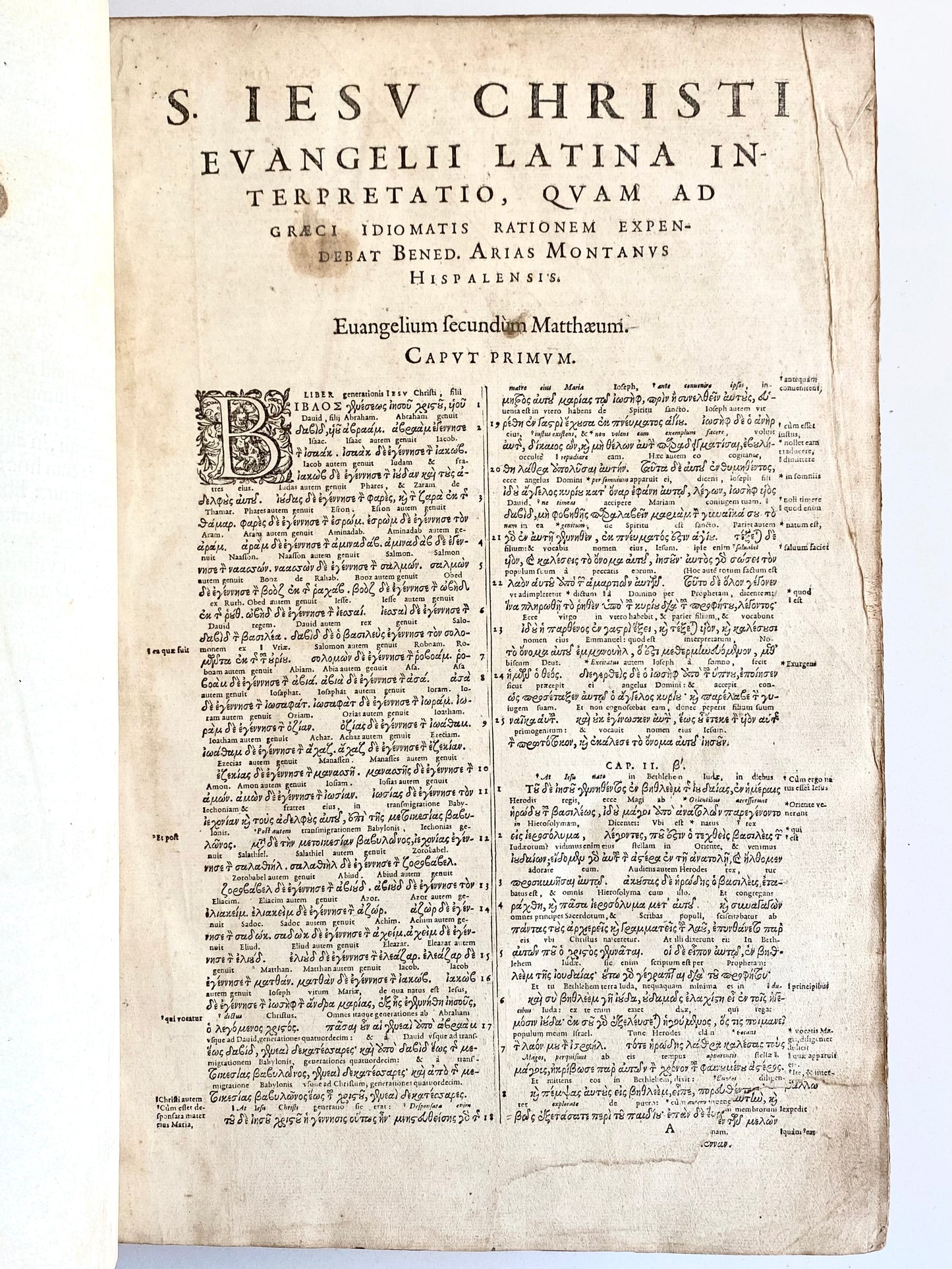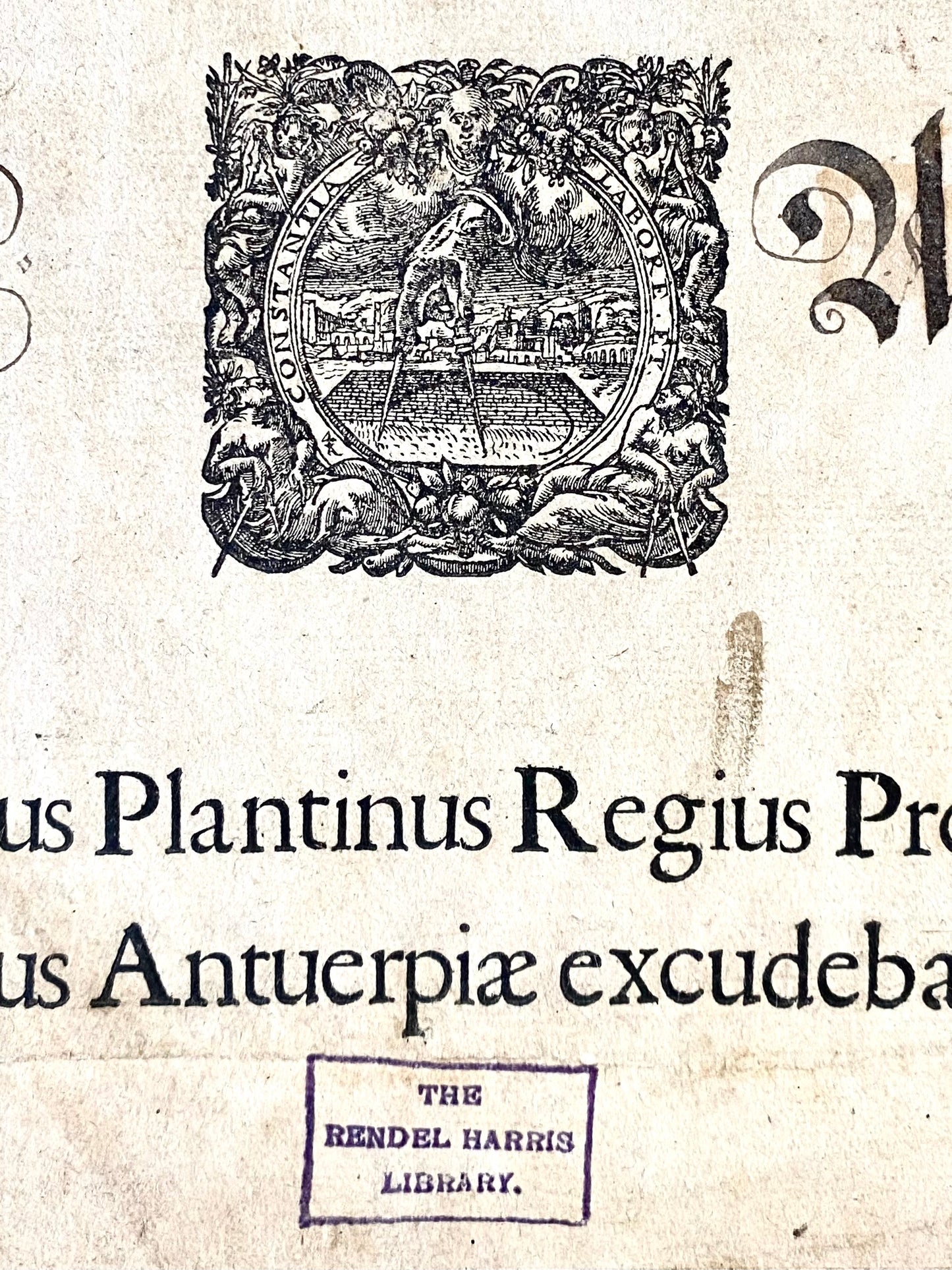Specs Fine Books
1572 CHRISTOPHER PLANTIN. Interlinear Old and New Testaments. The Greatest Biblical Printing of the Era.
1572 CHRISTOPHER PLANTIN. Interlinear Old and New Testaments. The Greatest Biblical Printing of the Era.
Couldn't load pickup availability
When Christie's sold off the Royal Copy of the Present Bible, all eight volumes issued separately, but bound for Philip II in matching calf, they echoed the words of historians, calling Plantin's Bible "The finest Bible ever printed in Christendom."
From its conception, the Plantin Polyglot Bible was a grand project: to produce the finest Bible in all Christendom, published under royal patronage of Philip II, King of Spain and Lord of the Seventeen Provinces of the Netherlands; it is therefore also known as the Biblia Regia. Even on the basis of advance sheets circulated at the Frankfurt book fair, it was celebrated by contemporaries for its importance and beauty, and European potentates vied to be associated with so ambitious and prestigious a project.
The Plantin Polyglot Bible is the second great Polyglot Bible. The Complutensian Polyglot Bible, printed at Alcalà in 1514-17, provided the foundation for the Plantin Polyglot, and a team of noted scholars under the editorship of the renowned Spanish orientalist Benedictus Arias Montanus scoured libraries across Europe for additional sources in order to establish the most up-to-date and reliable texts. Among the printed texts used were Bomberg’s Venice edition of the Hebrew, the Aldine edition of the Greek, and Widmanstädt’s edition of the Syriac text, and manuscripts included those at Alcalà consulted for the Complutensian Polyglot and at the Vatican. Joining the Biblical texts were additional works, brought together as an ‘Apparatus Sacra’, consisting of grammars, dictionaries, thesauri and a geography of the Holy Land.
Plantin devoted 5 years, up to 4 presses and 40 workmen to print the Bible. He had been acquiring types from the best type-cutters and designers of the day – Guillaume Le Bé and Cornelis van Bomberghen for Hebrew and Robert Granjon for Greek and Syriac – and he ordered four varieties of the finest paper to print the 1200 paper copies. Printing the Bible commenced in 1568 and by the summer of 1572 all but two volumes of the Apparatus Sacra (the third volume, containing the Hebrew and Greek Bibles, had been printed in 1571) and the privileges were complete. A hiatus then ensued, owing in part to a lack of ready cash but also to the political situation: an uprising in Zeeland against Spanish rule interrupted the supply of vellum. The final two volumes of the Apparatus and the privileges were printed later that year, only ever on paper.
Novvm Testamentvm Graece. Cum Vulgata Interpretatione Latina Graeci Contextus lineis inserta: Quaequidem Interpretatio, cum a Gracecarum Dictionum Proprietate Discedit, Sensum, Videlicet, Magis Quam verba Experimens, in Margine Libri est Collacata: Atque Alia Ben Ariae Montani Hispalensis, etc., Antwerp. Christopher Plantin. 1572. [with] Hebraicorvm Bibliorvm. Veteris Testamenti Latina Interpretatio, Opera Olim Xantis Pagnini Lucensis: NuncVero Benedicti Araei Montani Hispalesis, FrancisciRaphelengii Alnetani, Guidonis, & Nicolai Fabriciorum Boderianorum, etc. Antwerp. Christopher Plantin. 1572.
Being the first edition of the volume VII, issued separately and complete in and of itself, of Plantin's Polyglot Bible in a large 20+ pound folio. Contains the Old Testament in Hebrew and the New Testament in Greek, both with interlinear Latin translation. Adapted from Sante Pagnini's edition by Benito Arias Montano, F. Raphelengius and the brothers Le Fèvre de la Boderie for the first, edited by Montano for the second. Plantin's marks on the title pages.
A well-preserved copy from the library of the important 19th century scholar of ancient languages, Rendell Harris, so stamped and with corresponding bookplate. Also bears the bookplate of the famed library of Joseph Clark at Hindhayes which was deaccessioned in 1929. He likely received it from Harris or Harris' estate. Early signatures of Thomas Moore [calligraphic on Hebrew title page] and the important 18th century philologist, Nathiel Brassey Halhed [1751-1830]. Halhed's Bengali work of 1778 was instrumental in the work of William Carey and the Serampore Press as well. There is also a probably late 15th century signature we are unable to decipher.
One sheet of the Greek New Testament with minor losses to base of sheet affecting a few lines. The Hebrew title page relaid with minor losses. Generally very good, crisp and clean. Boards detached; in need of rebacking.
Share










































